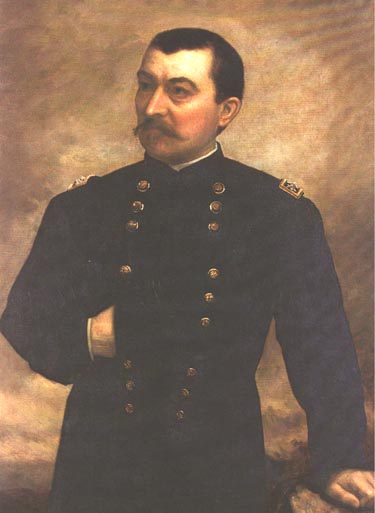
Philip Henry Sheridan was born in Albany, New York, on 6 March 1831; received a rudimentary education in a village school when his family moved to Somerset, Ohio; graduated from the United States Military Academy, July 1853; served as a brevet second lieutenant, 1st Infantry, on the Texas frontier and as a second lieutenant, 4th Infantry, on the northwestern frontier, 1854–1861; was promoted to first lieutenant, March 1861, then captain, 13th Infantry, May 1861; was quartermaster of the Army of Southwest Missouri and General Henry W. Halleck’s headquarters, 1861–1862; was appointed colonel, 2d Michigan Volunteer Cavalry, then commanded a brigade in Mississippi operations, May–July 1862; for his performance in the battle of Boonville, was promoted to brigadier general of volunteers; commanded a division in operations in Kentucky and Tennessee, including the battles of Perryville and Stones River, 1862; was promoted to major general of volunteers, December 1862; commanded a division in the battles of Chickamauga and Chattanooga, 1863; commanded the Cavalry Corps of the Army of the Potomac in the battles of the Wilderness, Todd’s Tavern, Yellow Tavern, and Trevilian Station, 1864; commanded the Army of the Shenandoah and the Middle Military Division, 1864–1865; was promoted to brigadier general (September) and major general (November) in the Regular Army, 1864; was cavalry field commander in the closing Civil War operations in Virginia, including Five Forks and Appomattox Station; commanded the Divisions of the Southwest and of the Gulf, 1865, the Department of the Gulf, 1866–1867, and the Fifth Military District, 1867, with Reconstruction responsibilities; commanded the Department of the Missouri, 1867–1869, and conducted successful winter operations against Central Plains tribes; was promoted to lieutenant general, March 1869; commanded the Division of the Missouri, 1869–1883, with military responsibility for the heart of the trans-Mississippi West; visited the German armies in the field, 1870–1871; married Irene Rucker, 1875; was commanding general of the United States Army, 1 November 1883–5 August 1888; urged congressional action to support the National Guard, pointed to the defenseless condition of the coasts to seaborne attack, made recommendations for a solution to the Indian problem, and sought a resolution of the problem of senior officer authority; was promoted to general, June 1888; died in Nonquitt, Massachusetts, on 5 August 1888.
The Artist
William F. Cogswell (1819–1903) was born in Sandusky, New York, and worked in a color factory in Buffalo before moving to New York City to take up a career as a professional artist and see his work exhibited at the National Academy of Design and the American Art Union. In 1849, the year of the gold rush, he visited California, where he later would settle in his declining years, and then returned to New York to continue his career. Cogswell’s portrait of Abraham Lincoln is in the White House collection and hangs in the National Museum of American Art; his Ulysses S. Grant portrait hangs in the Senate wing of the United States Capitol. General Philip H. Sheridan presented his Cogswell portrait to his valued aide and friend, Colonel Schuyler Crosby. It hangs in the headquarters of Readiness Region 3 at Fort George G. Meade, Maryland.
Philip Henry Sheridan
By William F. Cogswell
Oil on canvas, 44 3/8" x 32½", date unknown
[84]

page updated 30 April 2001